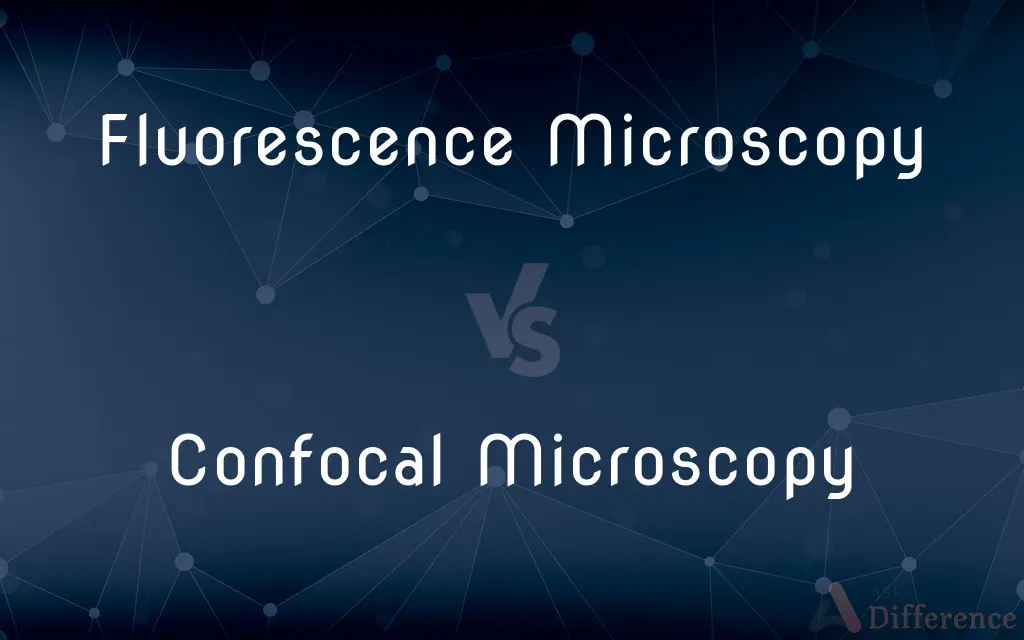Fluorescence Microscopy vs. Confocal Microscopy — What's the Difference?
By Tayyaba Rehman — Published on November 18, 2023
Fluorescence Microscopy visualizes specimens using fluorescence; Confocal Microscopy, a type of fluorescence microscopy, uses point illumination and a pinhole to eliminate out-of-focus light.

Difference Between Fluorescence Microscopy and Confocal Microscopy
Table of Contents
ADVERTISEMENT
Key Differences
Fluorescence Microscopy is a broad category of microscopy that employs fluorescence, a phenomenon where certain molecules absorb light at a specific wavelength and re-emit it at a longer wavelength, to visualize specimens. Confocal Microscopy, on the other hand, is a specific subtype of fluorescence microscopy designed to provide sharper, clearer images.
In Fluorescence Microscopy, when the specimen is illuminated with a specific wavelength, the fluorophores (fluorescent molecules) in the specimen get excited and emit light of a different wavelength, which is then detected to form an image. Confocal Microscopy also uses this principle but adds another layer of complexity. It uses point illumination and a pinhole to ensure that only light from a single, in-focus plane is detected, effectively removing out-of-focus light.
One major advantage of Fluorescence Microscopy is its ability to selectively stain and view specific components or structures within a specimen using different fluorophores. Confocal Microscopy enhances this by offering superior resolution and the ability to collect serial optical sections from thick specimens, thus providing three-dimensional reconstructions.
While Fluorescence Microscopy provides vital information about the spatial distribution of molecules, there is often a lot of background noise from out-of-focus regions. This is where Confocal Microscopy shines. By using the pinhole to eliminate this out-of-focus light, confocal systems generate clearer images, especially in thicker specimens.
Comparison Chart
Principle
Uses fluorescence to visualize specimens.
Uses fluorescence with point illumination and a pinhole for sharper images.
ADVERTISEMENT
Focus
Can have light from both in-focus and out-of-focus planes.
Eliminates out-of-focus light to capture only in-focus planes.
Resolution
Standard optical resolution.
Enhanced resolution, especially in Z-plane (depth).
Imaging Depth
Limited in thicker specimens due to background noise.
Capable of imaging thicker specimens with reduced noise.
Three-dimensional Imaging
Limited capability.
Can create detailed three-dimensional reconstructions.
Compare with Definitions
Fluorescence Microscopy
An optical imaging technique that highlights specific biological structures.
Fluorescence Microscopy highlighted the pathogen's presence within the infected tissue.
Confocal Microscopy
Employs laser point illumination to scan and image specimens.
The laser in Confocal Microscopy enabled precise imaging of the cell sample.
Fluorescence Microscopy
Reveals details by exciting fluorophores in the specimen.
Through Fluorescence Microscopy, the illuminated sample emitted a distinct glow.
Confocal Microscopy
A subtype of fluorescence microscopy that provides sharp, clear images.
Confocal Microscopy was essential in visualizing minute cellular structures.
Fluorescence Microscopy
Utilizes fluorescent probes or stains to target specific components.
With Fluorescence Microscopy, researchers stained the cell nucleus to study its morphology.
Confocal Microscopy
Uses a pinhole to eliminate out-of-focus light and improve resolution.
The advantage of Confocal Microscopy is the absence of blurry background signals.
Fluorescence Microscopy
A microscopy technique that employs fluorescence to image specimens.
Using Fluorescence Microscopy, scientists can view specific structures in cells.
Confocal Microscopy
Offers serial optical sectioning for detailed imaging depth.
With Confocal Microscopy, the team observed different layers of the skin tissue.
Fluorescence Microscopy
Allows visualization based on molecular interactions and light emissions.
Fluorescence Microscopy enables the observation of cellular processes in real-time.
Confocal Microscopy
Capable of producing three-dimensional reconstructions of thick specimens.
Scientists used Confocal Microscopy to map the layers within a tissue sample.
Common Curiosities
Why use Fluorescence Microscopy?
Fluorescence Microscopy allows selective visualization of specific structures in a specimen using different fluorescent molecules.
What are fluorophores in Fluorescence Microscopy?
Fluorophores are molecules that absorb and re-emit light, allowing visualization in Fluorescence Microscopy.
Which microscopy technique offers better resolution in thicker specimens?
Confocal Microscopy offers superior resolution in thicker specimens due to its elimination of out-of-focus light.
Are there samples unsuitable for Fluorescence Microscopy?
Samples without natural fluorescence need to be stained with fluorescent dyes or markers for Fluorescence Microscopy.
Does Confocal Microscopy always use a laser?
Yes, Confocal Microscopy typically employs a laser for point illumination.
What makes Confocal Microscopy unique?
Confocal Microscopy uses point illumination and a pinhole to remove out-of-focus light, providing sharper images.
Are there limitations to Fluorescence Microscopy?
Yes, Fluorescence Microscopy can have background noise from out-of-focus regions, especially in thicker specimens.
How does Fluorescence Microscopy work?
Fluorescence Microscopy uses fluorescence where molecules absorb light at a specific wavelength and re-emit it at a longer wavelength to visualize specimens.
Is Confocal Microscopy a type of Fluorescence Microscopy?
Yes, Confocal Microscopy is a subtype of Fluorescence Microscopy.
Which technique is better for imaging deep into samples?
Confocal Microscopy is more suited for imaging deeper into samples due to its optical sectioning ability.
Can Confocal Microscopy produce 3D images?
Yes, Confocal Microscopy can create three-dimensional reconstructions from serial optical sections.
Why is there reduced background in Confocal Microscopy?
The pinhole in Confocal Microscopy eliminates out-of-focus light, reducing background noise.
Share Your Discovery

Previous Comparison
Dachshund vs. Miniature Dachshund
Next Comparison
Noodles vs. PastaAuthor Spotlight
Written by
Tayyaba RehmanTayyaba Rehman is a distinguished writer, currently serving as a primary contributor to askdifference.com. As a researcher in semantics and etymology, Tayyaba's passion for the complexity of languages and their distinctions has found a perfect home on the platform. Tayyaba delves into the intricacies of language, distinguishing between commonly confused words and phrases, thereby providing clarity for readers worldwide.
















































